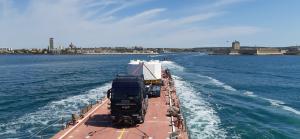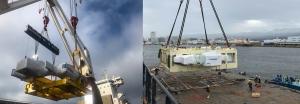Busy times on roads and oceans
It is a busy time for transport and deliveries. Major ITER components are presently sailing the Indian and Pacific oceans, driving on the roads near Houston, and travelling by night along the ITER Itinerary.
Shipped in early July from the United States, the first central solenoid module was unloaded at Fos-sur-Mer on 25 July and is expected on site on 9 September. A second module has already travelled approximately 2,400 kilometres between the General Atomics facility near San Diego, California, and the port of Houston, Texas. Now, it is ready to cross the Atlantic.
On other points of the globe, three toroidal field coils are heading in the direction of ITER. Toroidal field coil #6 from Europe (TF6) was unloaded at Fos-sur-Mer on 20 August and will be delivered on 3 September. TF2 from Japan left the port of Kobe on 23 August and will reach southern France at the end of this month; a second Japanese coil, TF10, sailed from Yokohama on 20 August and should arrive at Fos-sur-Mer at about the same time.
These five major components arrive on the heels of vacuum vessel sector #1(7), which travelled this summer from Korea and reached ITER on 27 August.
All in all, since the first Highly Exceptional Load was delivered in January 2015, 130 such shipments have been organized and safely received at ITER. Over the past year and a half, the rhythm of major component deliveries has significantly accelerated as machine assembly got off to a start.



